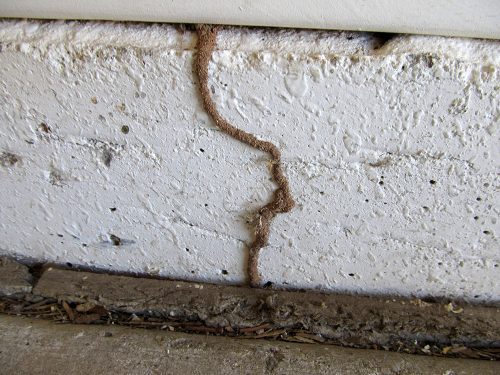There are quite a few different species of termites that exist around the world depending primarily on climate. In Tucson and around Southern Arizona, we almost exclusively see the Subterranean Termites attacking homes and structures.
Termites are social insects that create colonies together that function by carrying out specific roles within the colony. This consists of reproductive adults, soldiers and workers. Generally speaking what we see around our homes are workers – these insects are responsible for feeding maintaining the colony, finding food, and bringing resources back into the colony.
Subterranean Termites
This species of termite build their colonies below ground in areas that are advantageous for food foraging. They must maintain contact with the soil to meet their livable requirements both in temperature and moisture content. termites forage through soil in search of food sources and construct mud tubes that protect them from dehydration until they can return to their colony to replenish moisture and feed other members of the colony.
Subterranean termite colonies can grow to millions of insects over the course of 3-5 years, and are responsible for as much as a billion dollars of damage annually. Termites also work continuously 24/7. As they grow and multiply, a single colony can destroy about a one-foot section of a 2×4 over the course of five or six months.
Identifying a Problems

The key to ensuring that termites don’t cause a significant amount of damage to your home, early detect in is key. Termites can be incredibly active and grow very quickly. The signs that they are active luckily are typically very visible. As homes are built upon elevated foundations in standard family homes or raised mobile homes, termites have to create pathways to gain access to food so they can carry it back to the colony.
These tunnels, or tubes, are what we look for to see if there is active termites that are gaining access to a home. Almost every type of home is susceptible because even if the certain elements of the exterior are not edible, virtually everything on the inside of a home is on the menu. For example, steel buildings still typically contain drywall interior walls with paneling baseboards, all of which are very much edible for termites.
Prevention is KEY!
The most cost effective way to ensure your home stays termite free is to take it off the menu completely. Termite treatments are proven to be effective at maintaining a barrier around your home. They don’t last forever however. Chemicals used to shield your home simply deteriorate over time and must be renewed every few years on average. You can trust that termite damage will cost quite a bit more than any termite treatment, so we point out that by saving a few bucks on not treating your home might end up costing you 5 times that amount to repair it. Make sure you budget in a new termite treatment every few years.
If you can’t remember the last time you had your home treated, please consider calling us for a completely FREE home inspection. No strings attached. Our professionals can tell you if your home is termite-free, and if not we can tell you the severity and offer you a quote with options on how to proceed. We’re not happy unless you’re happy! Contact us today to learn more!
